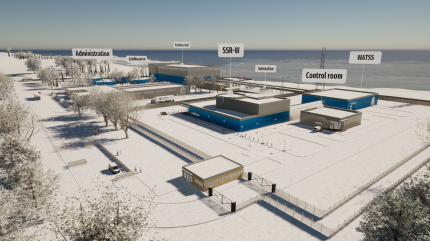
Fuel cycle modelling has demonstrated the ability of Moltex Energy Canada’s Stable Salt Reactor – Wasteburner (SSR-W) to consume used nuclear fuel. The peer-reviewed research paper, Wasteburning Performance of the Moltex SSR-W, was delivered at the recent Generation IV and Small Reactors conference in Ottawa.
The SSR-W, a fast spectrum molten salt reactor fuelled with recycled spent fuel, has been selected to be built at the Point Lepreau NPP site in New Brunswick by NB Power. “A fast neutron reactor specifically designed as a wasteburner enables the fission of all actinides in the generation of electricity, mitigating both the problems of spent fuel waste and fresh fuel availability,” the paper notes.
Moltex is also developing the Waste to Stable Salts (WATSS) process, through which fuel salt is produced from existing spent fuel, and the fuel cycle is closed by repeated recycling of fuel salt that has been used in the SSR-W.
The paper presents results from modelling this fuel cycle and demonstrates that with repeated fuel recycling an equilibrium can be reached where the concentration of all actinides is reduced during burnup in the reactor and actinide burning can continue indefinitely. The combination of this actinide burning in the reactor and the separation of most fission products in the recycling process results in a large reduction in waste volume, radiotoxicity and heat generation. “The flexibility of the fuel cycle is also demonstrated, enabled by the recycling process, online refuelling and a fuel salt chemistry that allows variation of the conversion ratio.”
Moltex says the research “highlights that the SSR-W, developed by teams in New Brunswick, Ontario, the UK, and the USA, can consume the vast majority of transuranic elements (TRU) present in used fuel bundles from Canada’s Candu reactors”. These transuranic elements, which are created during the fission process, are radioactive for thousands of years. “Unlike traditional reactors that accumulate these elements over time, the SSR-W is designed to consume them as fuel, presenting an innovative approach to reducing nuclear waste.”
“The SSR-W was specifically engineered to efficiently reuse and consume recycled nuclear waste,” said Moltex CEO Rory O’Sullivan. “This breakthrough research, the result of years of collaboration, clearly demonstrates that ability.”
The paper concludes: “A SSR-W reactor with a thermal power of 1,200 MWth eliminates 425 kg of actinides on an annual basis, or about 25 metric tons over its lifetime, with a fuel salt composition and isotopic vector that evolves to reach an equilibrium. At this point, the required top-up of TRUs from freshly recycled Candu fuel is constant and corresponds to the amount of TRU transmuted.”
It notes: “At the end of operational lifetime of the reactor, the TRU content of the last core load would be significantly lower than the quantities recycled from the spent Candu spent fuel inventory, which would otherwise be considered as waste. Moreover, the reactor will have produced energy which, if produced by a thermal reactor, would have generated more transuranic actinides rather than a net reduction. Finally, the end-of-life core load could itself be recycled and used as start-of-life core load for a new SSR-W, therefore fully closing the cycle.”
According to Moltex, the SSR-W “can recycle used fuel indefinitely, producing a minimum of 6,000 MW of clean energy from Canada’s existing CANDU reactor fuel without the need for new fuel imports”. This gives the SSR-W a key advantage over other advanced reactor technologies, which can only recycle used fuel once or a limited number of times.
“Our fuel source is already sitting in stockpiles at nuclear sites around the country,” O’Sullivan noted. “This means we can tap into these resources to produce clean power for years to come.” With respect to the WATSS, Moltex says it is working with the Nuclear Waste Management Organisation to ensure that any final waste products requiring disposal can be disposed of via established disposal routes in Canada.
Moltex says it is developing “three unique technologies”: the SSR-W; the WATSS process; and GridReserve thermal energy storage tanks, enabling the SSR-W to act as a peaking plant. It aims to deploy first-of-a-kind SSR-W, WATSS and GridReserve units at the Point Lepreau NPP site by the early 2030s.






